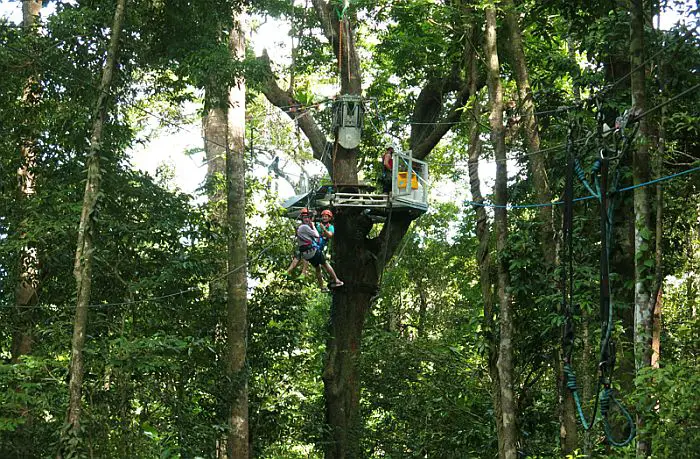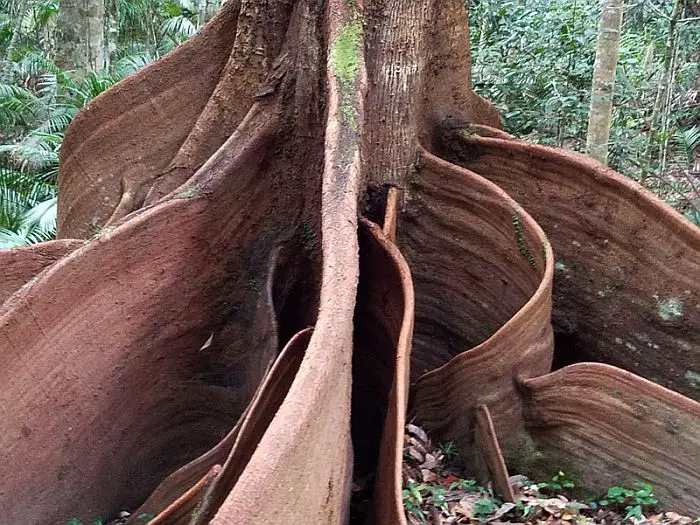Surfing the Rainforest in Queensland
Story and photos by Michael Buckley
Under the spell of the enchanted Daintree Rainforest, where ancient trees and deadly fruits rule in northern Queensland, Australia.

We grab our helmets. I am going to be a Chewbacca for the afternoon. A Wookiee let loose in the treetops. Yeeehaaa! And along for the ride are Princess Leia—and Wonder Woman. And Rambo. After suiting up, we head over to the human hamster wheel. Yes, at Daintree’s Jungle Surfing Zipline, that’s how you start the adventure. Zipliners take turns to pace a treadmill that provides enough lift for others to rise up and reach the first tree-top platform.

We are high in the canopy of Daintree Rainforest, near Cape Tribulation, in far-north Queensland. This exhilarating tree-top course consists of seven ziplines—one of them an adrenalin-inducing 78 meters long. The outfit is remarkably well-run—unlike other ziplines I have been on. Safety is paramount: the guides control the braking and they do the talking. That’s the point of being up here—to gain insight into the canopy, once the exclusive domain of scientific researchers—to whom we owe a big debt, because they developed the equipment that is now used by zipline operators the world over.
Our canopy guide takes time out at each platform to explain our surroundings--pointing to large epiphytes in the canopy, talking about insects and wildlife. But even he is stymied when it comes to details about the hardy trees that are hosting us. I ask him about a thick tree at a platform 20 meters up in the canopy. How old? Five hundred years old, he hazards a guess. I am awestruck; how can the tree reach that age? Is the guide pulling my leg? Imagine being a tree weathering 490 years—surviving fires, disasters, being assaulted by bugs, and hosting birds and small animals—and then along come some zipliners who have the nerve to use your upper heights for sport! This may have given the tree some pause, or maybe the tree is happy to host humans who will protect it from nasty loggers.

You won’t spot wild animals from the zipline—they are very shy. But there are certainly some unusual endemic species around. The Tree Kangaroo, for instance, the Musky Rat Kangaroo, plus the Orange-footed Scrubfowl. Chances for wildlife encounters are actually better at night. The same outfit runs a night walk, where you may spot a striped possum or two, and some creepy crawly critters. You will likely see some glowing mushrooms, fluorescing just like those in the movie Avatar. Why do mushrooms fluoresce? Botanists have no idea.
Throwback to the Dinosaurs
Cape Tribulation was so christened by Captain James Cook because his ship was stranded there for repairs after it struck the Great Barrier Reef in 1770. But that, no doubt, was a boon for the on-board naturalist, Joseph Banks, who was tasked with a frenzy of collecting and describing novel specimens of flora and fauna. Most proved to be endemic. And there are still scores of unknown plant species out there in Australia, yet to be described.
I am not a botanist. For me, this journey starts with that single throw-away line from the zipline guide—about the 500-year-old tree we were precariously perched on. How can a tree possibly live that long? This triggers a quest to find out more. I indulge in hiking at ground level in different parts of the region: at Daintree World Heritage Rainforest and in some private reserves. I come across some tremendous tall trees, growing at heights I could not imagine in the tropics—dwarfed by the immense roots of a Crows Foot Ash, and gaping in wonder at a towering Rose Satin Ash.

It turns out that Daintree Rainforest, once thought to be the youngest rainforest in the world, is actually the oldest continuously surviving rainforest on the planet. It dates back more than 140 million years, to the age of the dinosaurs. Of the 19 primitive flowering plant species known on the planet, 12 are found in Daintree Rainforest. Discovered in 1971 is a plant with a direct link to the dinosaur age: the Idiot Fruit (Idiospermum australiense). It was thought to be gone forever.
Only a fool would eat the Idiot Fruit. Why? Because it would kill you. The species was re-discovered because four cows ate the seeds—and died—and an autopsy revealed those seeds. No species is known to eat it. The species that may have eaten it in the past have all died out. The Idiot Fruit is so named as an errant transcription of its Latin name, with “idio” being Greek for “peculiar.” It is the most primitive of flowering plants, more of a flower than a fruit.
Copyright (C) Perceptive Travel 2017. All rights reserved.
- Biking Across Borders in the Balkans by Tim Leffel
- Taking the Carolina Hometown Tour by Lydia Carey
- Their Northernmost Life in Arctic Norway by David Nikel
- Travel Book Reviews by William Caverlee
Books from the Author:

Buy Tibet, Disrupted online here:
Apple iBooks

Buy Meltdown in Tibet at your local bookstore, or get it online here:
Buy on Amazon
Kobo

Buy Tibet: the Bradt Travel Guide at your local bookstore, or get it online here:
Buy on Amazon

